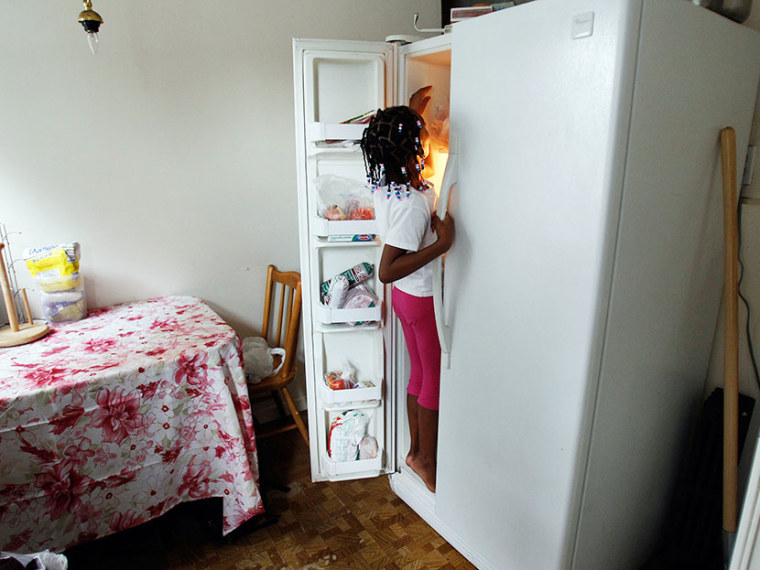UPDATED 2:43 P.M.
Three weeks after the House killed a farm bill that included massive food stamp cuts, Republicans are reportedly considering rolling the cuts into a separate piece of legislation. A new version of the farm bill, absent any provisions related to food stamps, would also be introduced on the House floor. If the plan works, then food stamp cuts may ultimately be even deeper than anticipated.
Democrats opposed the version of the 2013 House farm bill on June 20 because it would have cut $20.5 billion in funding for SNAP (Supplemental Nutrition Assistance Program, colloquially known as food stamps) over the next decade. After Republicans blocked a Democratic amendment to the farm bill which would have restored the food stamp cuts, Democrats succeeded in defeating the bill as a whole. They were joined by some Republicans who opposed the $20.5 billion in cuts for not being significant enough.
To get a solid majority of the farm bill—an omnibus bill, typically passed every five years or so, which regulates and subsidizes various programs related to agriculture and food production—House Speaker John Boehner, R-Ohio, had two options: He could either try to win over some Democrats and risk alienating even more Republicans by restoring a little of the SNAP funding, or he could make the cuts even harsher to please those hard-line Republicans who had defected from the bill. In the end, the Republican leadership reportedly decided to split the difference by bracketing the food stamp debate from the rest of the farm bill.
House Agriculture Committee chair Frank Lucas, an Oklahoma Republican, has indicated his support for the move. His committee was the one which originally submitted the 2013 farm bill, SNAP cuts and all, to the House floor.
“I’m willing to do what it takes to get a farm bill done,” Lucas told reporters Tuesday morning. “If that means doing it unconventionally, maybe we got to give it a try.”
But Massachusetts Democratic Rep. Jim McGovern fears that splitting the farm bill in two would open the door to even deeper food stamp cuts.
"What they should do is bring back a full farm bill that doesn't devastate SNAP, but what they're going to do instead is bring a separate SNAP bill that's even worse," McGovern spokesperson Michael Mershon told msnbc. A food stamp bill that cuts even more from the program would likely draw enough Republican votes to constitute a majority.
The $20.5 billion in cuts already rejected by the House would have caused nearly two million people to lose SNAP eligibility and an additional 210,000 children to lose free school meals, according to a report from the Center on Budget and Policy Priorities (CBPP). A House bill dealing only with SNAP might include cuts which are closer to those proposed in Rep. Paul Ryan's most recent budget. The latest Ryan budget would cut a full $135 billion from SNAP, which CBPP estimates would cause over eight million people to lose eligibility.
The Senate passed its own farm bill, which cuts a comparatively modest $4 billion from SNAP, in early June. If the House passes a farm bill and a SNAP bill separately, then Republicans could use the SNAP bill to negotiate even deeper cuts in a conference committee version of the farm bill.
"Say the Senate farm bill contains $4 billion in SNAP cuts and the House farm bill that went down contains $20 billion, so now you're trying to conference something between $4 billion and $20 billion," said Mershon. "But what happens if the House Republicans bring a $40 billion cut? Now you're conferencing between $4 billion and $40 billion, which is a lot worse."
The agricultural industry appears to be uniformly against splitting food stamps and farming policy into separate pieces of legislation. Last week, over 500 farm groups co-signed a letter to House leadership asking them not to carve food stamp legislation out of the farm bill.
"We believe that splitting the nutrition title from the rest of the bill could result in neither farm nor nutrition programs passing, and urge you to move a unified farm bill forward," read the letter.
UPDATE: A spokesperson for the House Agricultural Committee confirmed that House leadership is looking at a plan to carve SNAP benefits out of the farm bill, and that Rep. Lucas would support the plan under certain conditions. Below is an excerpt from an email sent in response to an msnbc.com request for comment:
House leadership is considering splitting the farm bill.It’s not the preference of Chairman Lucas to split the bill, but he wants to get a new farm bill enacted and will do what’s necessary to accomplish that goal. If leadership can deliver the votes, he will support it.
